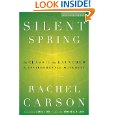In 1962 with a formal background in biology, countless publications for the Bureau of Fisheries and the US Fish and Wildlife Service, Rachel Carson added to her volumes of work Silent Spring
, arguably the most enduring, controversial, and legendary books of the modern Sustainability Era.
Doubting her ability to find a magazine willing to publish a single article on the pessimistic topic of the effect of chemicals on the environment, Carson decided instead to produce a full length book. Serialized in the New Yorker (desribed at the NRDC) prior to the 1962 publication, Silent Spring
quickly became the focus of incredible public attention. Coupled with this growing attention, the chemical industry responded to Silent Spring with a focused quarter-million-dollar campaign aiming to discredit Carson. Despite the concerted effort by the chemical industry, a Presidential commission began looking into the issues – and Congress began considering tougher restrictions on chemicals. (Carson testified before Congress.)
Poignantly, Silent Spring is essentially a survey of research on pesticides, begins artistically with a story depicting a town having suffered a series of plagues. At the end of this chapter, Carson tells us that the town is fictitious, however, she adds that each of the events recounted “has actually happened somewhere.”
Lending substance to the original story, Carson goes on to describe the source of the plagues as newly designed man-made chemicals applied in massive quantities almost everywhere. In doing this Carson introduces the singular analogy that runs through Silent Spring: “pesticides are like atomic radiation—invisible, with deadly effects that often manifest themselves only after a long delay.” Further, she identifies the qualities that are increasing the danger of these new chemicals/pesticides over their predecessors:
- Greater chemical potency
- Slower breakdown and decomposition of the chemicals
- A tendency for the chemicals to become concentrated in fatty tissue.
For Carson, it is also important to note that while a toxin may not constitute a severe danger in limited exposure and dose, danger occurs with ultimate accumulation in the body, and concentration up the food chain.

 via
via